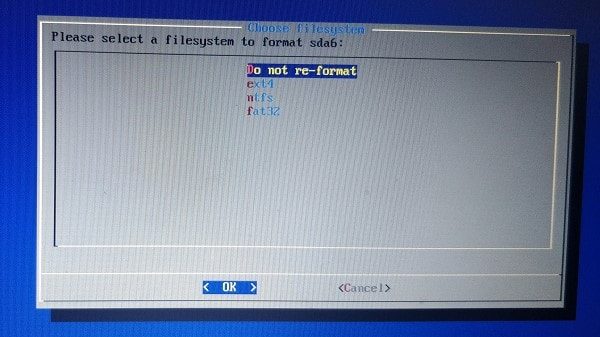

- DUAL BOOT CREATE BOOT PARTITION INSTALL
- DUAL BOOT CREATE BOOT PARTITION FULL
- DUAL BOOT CREATE BOOT PARTITION WINDOWS 10
- DUAL BOOT CREATE BOOT PARTITION PORTABLE
- DUAL BOOT CREATE BOOT PARTITION ISO

Under the Advanced startup option, click on Restart now button. In the Windows menu, search for UEFI and then click on ‘Change advanced startup options’: You may choose to access the UEFI settings when the system starts by pressing F2/F10/F12 button but a more robust way is go through Windows. Once you have the live Ubuntu USB ready, the next step is to boot from it. Hit the start button and wait for the process to complete.
DUAL BOOT CREATE BOOT PARTITION ISO
It automatically identifies the plugged in USB but double check it anyway. Then browse to the location of the downloaded ISO image and ensure that it uses GPT partitioning scheme and UEFI target system. Make sure it doesn’t have any important data because it will be formatted. If you need to download Ubuntu via torrents, you can find it under the ‘alternative downloads’. Go to Ubuntu’s website and download the ISO file. 29.3 GB free space on SSD and 195.3 GB free space on HDD. Here’s what the final disk scenario looks like for my system. You are free to decide how much space you want to allocate to Ubuntu. I made around 200 GB of free space for Linux. Anything between 20 and 40 GB is a fair choice. I have given it 30 GB which is a decent disk space for the root partition. It will give you the largest possible disk partition you can make here. Right click on the SSD and choose Shrink Volume option. You have to shrink both SSD and HDD one by one and make some free space that will be utilized later for installing Ubuntu Linux. In the Windows menu, search for disk and go to ‘Create and format hard disk partitions’.

Step 2: Make disk partition for Ubuntu installation
DUAL BOOT CREATE BOOT PARTITION PORTABLE
Toshiba Canvio Advance 1TB Portable External Hard Drive USB 3.0, Black - HDTCA10XK3AA You can use an external HDD (slower but cheaper) or SSD (faster but expensive) and copy the important files and folders on it. This is optional but having a backup is always a good idea. Since you’ll be dealing with disk partitions, it will be wise to make a copy of your important files on an external disk. Optional: Windows recovery disk (if you encounter any major boot issues, it could be fixed).Optional: External USB disk for making back up of your data.Internet connection (for downloading Ubuntu ISO image and live USB creating tool).A USB key (pen drive or USB drive) of at least 4 GB in size and no data on it.
DUAL BOOT CREATE BOOT PARTITION WINDOWS 10
DUAL BOOT CREATE BOOT PARTITION INSTALL
I have used an Acer Predator gaming laptop in this tutorial to install Ubuntu alongside Windows. Dual boot Ubuntu and Windows on a system with SSD and HDD I recommend going with the third option for dual booting on separate hard drives and this is what I am going to show you in this tutorial. But this could be complicated to set specially with fast boot enabled on Windows which would mean special efforts to auto-mount the partitions. This way, application-specific files like browser caching utilize the SSD and other big files stay on HDD. And you make a partition on the HDD and then soft link it to your Music, Videos and Downloads folder. This way, you boot faster into Linux and you have plenty of disk space for your personal documents and downloads. You keep the root (and thus swap and boot) on SSD and you put your Home directory on HDD. You’ll have plenty of disk space, but Linux will boot slower, and you won’t get the SSD advantage. This could work if you have 180 GB or 200 GB or more on SSD but won’t work with 120 GB SSD.
DUAL BOOT CREATE BOOT PARTITION FULL
You’ll get full advantage of SSD speed, but then you will have only a limited disk space. Now, if you want to dual boot on a system with two disks, you may get confused about where should you be installing Linux. 1 TB SSD would increase the system price a lot and hence this particular combination of SSD and HDD. This is usually the scene with gaming laptops where large disk space matters for storing game files but SSD is required for faster boot and computing experience. It comes with a SSD with limited disk space like 120 GB and an additional HDD with 500 GB or 1 TB disk space. Here’s the scenario: you got a new computer. Why? Because the scenario is slightly different and several It’s FOSS readers have asked questions about this particular scenario.

Recently, I also wrote about dual booting on a Bitlocker encrypted Windows system.Īnd yet here I am talking about it again. Dual booting Ubuntu and Windows is not that complicated and I have covered it in detailed tutorial in the past.


 0 kommentar(er)
0 kommentar(er)
